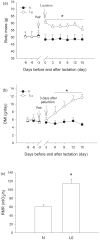No evidence for a trade-off between reproductive investment and immunity in a rodent
- PMID: 22649512
- PMCID: PMC3359356
- DOI: 10.1371/journal.pone.0037182
No evidence for a trade-off between reproductive investment and immunity in a rodent
Abstract
Life history theory assumes there are trade-offs between competing functions such as reproduction and immunity. Although well studied in birds, studies of the trade-offs between reproduction and immunity in small mammals are scarce. Here we examined whether reduced immunity is a consequence of reproductive effort in lactating Brandt's voles (Lasiopodomys brandtii). Specifically, we tested the effects of lactation on immune function (Experiment I). The results showed that food intake and resting metabolic rate (RMR) were higher in lactating voles (6≤ litter size ≤8) than that in non-reproductive voles. Contrary to our expectation, lactating voles also had higher levels of serum total Immunoglobulin G (IgG) and anti-keyhole limpet hemocyanin (KLH) IgG and no change in phytohemagglutinin (PHA) response and anti-KLH Immunoglobulin M (IgM) compared with non-reproductive voles, suggesting improved rather than reduced immune function. To further test the effect of differences in reproductive investment on immunity, we compared the responses between natural large (n≥8) and small litter size (n≤6) (Experiment II) and manipulated large (11-13) and small litter size (2-3) (Experiment III). During peak lactation, acquired immunity (PHA response, anti-KLH IgG and anti-KLH IgM) was not significantly different between voles raising large or small litters in both experiments, despite the measured difference in reproductive investment (greater litter size, litter mass, RMR and food intake in the voles raising larger litters). Total IgG was higher in voles with natural large litter size than those with natural small litter size, but decreased in the enlarged litter size group compared with control and reduced group. Our results showed that immune function is not suppressed to compensate the high energy demands during lactation in Brandt's voles and contrasting the situation in birds, is unlikely to be an important aspect mediating the trade-off between reproduction and survival.
Conflict of interest statement
Figures





Similar articles
-
Limits to sustained energy intake. XI. A test of the heat dissipation limitation hypothesis in lactating Brandt's voles (Lasiopodomys brandtii).J Exp Biol. 2009 Nov;212(Pt 21):3455-65. doi: 10.1242/jeb.030338. J Exp Biol. 2009. PMID: 19837887
-
Large litter size increases maternal energy intake but has no effect on UCP1 content and serum-leptin concentrations in lactating Brandt's voles (Lasiopodomys brandtii).J Comp Physiol B. 2008 Jul;178(5):637-45. doi: 10.1007/s00360-008-0255-y. Epub 2008 Feb 19. J Comp Physiol B. 2008. PMID: 18283466
-
Humoral immune response suppresses reproductive physiology in male Brandt's voles (Lasiopodomys brandtii).Zoology (Jena). 2009;112(1):69-75. doi: 10.1016/j.zool.2008.04.006. Epub 2008 Nov 28. Zoology (Jena). 2009. PMID: 19041232
-
Litter Size Reduction as a Model of Overfeeding during Lactation and Its Consequences for the Development of Metabolic Diseases in the Offspring.Nutrients. 2022 May 13;14(10):2045. doi: 10.3390/nu14102045. Nutrients. 2022. PMID: 35631188 Free PMC article. Review.
-
Life history trade-offs and the partitioning of maternal investment: Implications for health of mothers and offspring.Evol Med Public Health. 2018 Aug 16;2018(1):153-166. doi: 10.1093/emph/eoy014. eCollection 2018. Evol Med Public Health. 2018. PMID: 30152817 Free PMC article. Review.
Cited by
-
No evidence of metabolic costs following adaptive immune activation or reactivation in house sparrows.Biol Lett. 2022 Jun;18(6):20220036. doi: 10.1098/rsbl.2022.0036. Epub 2022 Jun 15. Biol Lett. 2022. PMID: 35702980 Free PMC article.
-
Immune response from a resource allocation perspective.Front Genet. 2012 Dec 14;3:267. doi: 10.3389/fgene.2012.00267. eCollection 2012. Front Genet. 2012. PMID: 23413205 Free PMC article.
-
A global-scale dataset of bat viral detection suggests that pregnancy reduces viral shedding.Proc Biol Sci. 2025 Apr;292(2045):20242381. doi: 10.1098/rspb.2024.2381. Epub 2025 Apr 16. Proc Biol Sci. 2025. PMID: 40237082
-
A global-scale dataset of bat viral detection suggests that pregnancy reduces viral shedding.bioRxiv [Preprint]. 2024 Feb 26:2024.02.25.581969. doi: 10.1101/2024.02.25.581969. bioRxiv. 2024. Update in: Proc Biol Sci. 2025 Apr;292(2045):20242381. doi: 10.1098/rspb.2024.2381. PMID: 38464184 Free PMC article. Updated. Preprint.
-
Hot and scared: how do heatwaves and predation risk impact resource acquisition and allocation?Biol Lett. 2024 Apr;20(4):20240009. doi: 10.1098/rsbl.2024.0009. Epub 2024 Apr 24. Biol Lett. 2024. PMID: 38653332 Free PMC article.
References
-
- Demas GE, Chefer V, Talan MI, Nelson RJ. Metabolic costs of mounting an antigen-stimulated immune response in adult and aged C57BL/6J mice. Am J Physiol Regul Integr Comp Physiol. 1997;273:R1631–1637. - PubMed
-
- Lochmiller RL, Deerenberg C. Trade-offs in evolutionary immunology: just what is the cost of immunity? Oikos. 2000;88:87–98.
-
- Derting TL, Compton S. Immune response, not immune maintenance, is energetically costly in wild white - footed mice (Peromyscus leucopus). Physiol Biochem Zoo. 2003;76:744–752. - PubMed
Publication types
MeSH terms
Substances
LinkOut - more resources
Full Text Sources

